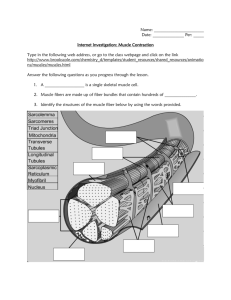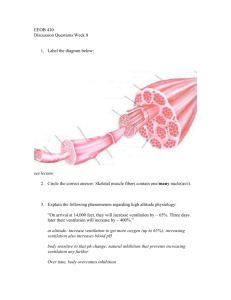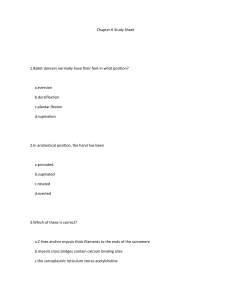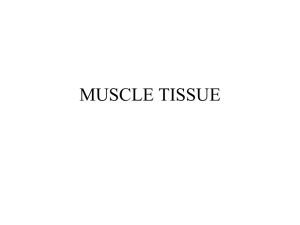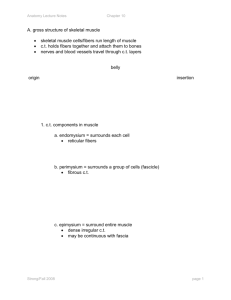WEEK 5: Muscle Contraction
advertisement
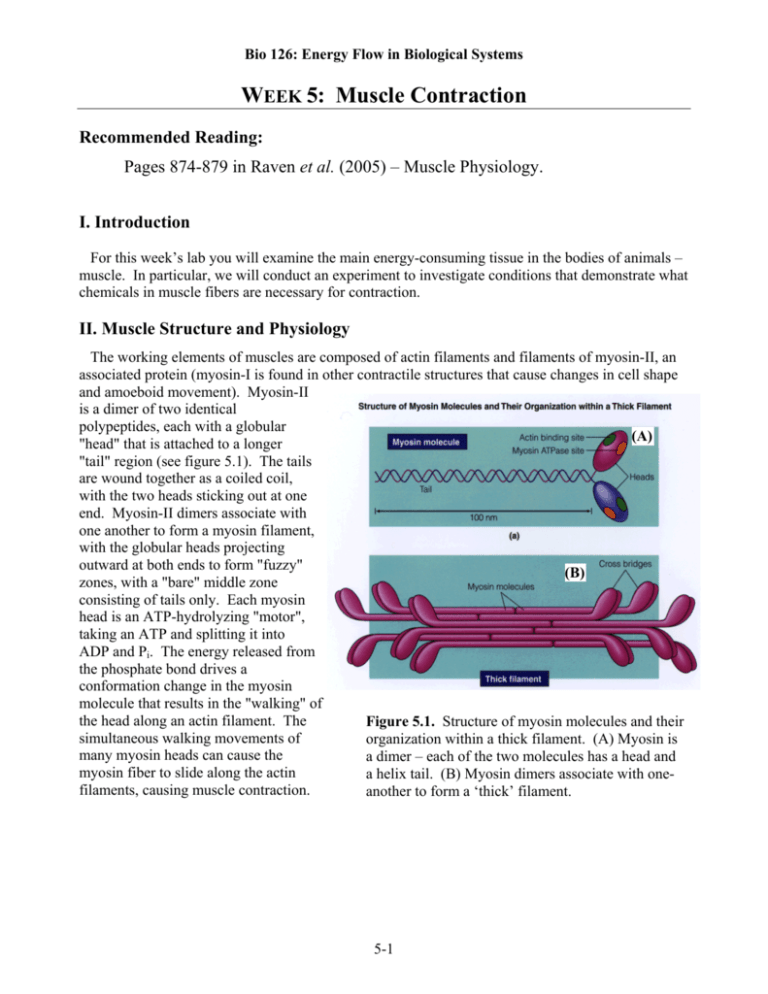
Bio 126: Energy Flow in Biological Systems
WEEK 5: Muscle Contraction
Recommended Reading:
Pages 874-879 in Raven et al. (2005) – Muscle Physiology.
I. Introduction
For this week’s lab you will examine the main energy-consuming tissue in the bodies of animals –
muscle. In particular, we will conduct an experiment to investigate conditions that demonstrate what
chemicals in muscle fibers are necessary for contraction.
II. Muscle Structure and Physiology
The working elements of muscles are composed of actin filaments and filaments of myosin-II, an
associated protein (myosin-I is found in other contractile structures that cause changes in cell shape
and amoeboid movement). Myosin-II
is a dimer of two identical
polypeptides, each with a globular
(A)
"head" that is attached to a longer
"tail" region (see figure 5.1). The tails
are wound together as a coiled coil,
with the two heads sticking out at one
end. Myosin-II dimers associate with
one another to form a myosin filament,
with the globular heads projecting
outward at both ends to form "fuzzy"
(B)
zones, with a "bare" middle zone
consisting of tails only. Each myosin
head is an ATP-hydrolyzing "motor",
taking an ATP and splitting it into
ADP and Pi. The energy released from
the phosphate bond drives a
conformation change in the myosin
molecule that results in the "walking" of
the head along an actin filament. The
Figure 5.1. Structure of myosin molecules and their
simultaneous walking movements of
organization within a thick filament. (A) Myosin is
many myosin heads can cause the
a dimer – each of the two molecules has a head and
myosin fiber to slide along the actin
a helix tail. (B) Myosin dimers associate with onefilaments, causing muscle contraction.
another to form a ‘thick’ filament.
5-1
Bio 126 - Week 5 – Muscle Contraction
Skeletal (striated) muscle, cardiac (heart)
muscle and smooth muscle all use myosin
thick filaments to slide actin thin filament
bundles to produce muscle contraction.
Although the precise structures of these three
muscle types differ, the basic contractile
mechanism is the same. Skeletal muscle
consists of long fibers, which are really
enormous single cells that form when separate
smaller cells fuse during development. Each
muscle fiber (cell) is multinucleated,
possessing the nuclei derived from the
individual cells that fused during
development; these nuclei are located just
beneath the plasma membrane. The
cytoplasm of a muscle fiber is packed with
long, cylindrically-shaped structures about 1-2
µm in diameter – these so-called myofibrils
are the contractile components of muscle.
Each myofibril in striated muscle is organized
as a linear chain of repeating, microscopic
contractile units termed sarcomeres. Each
sarcomere is about 2.5 µm long, in its relaxed
state, and consists of myosin-II filaments
(thick filaments), actin filaments (thin
filaments) and associated proteins, organized
into Z-discs, an A-band and I-bands (see
figure 5.2). The plus ends of the thin
filaments are embedded in and anchored to the
Z-discs, which form the boundaries of the
sarcomere. Centrally-located thick filaments
overlap with the thin filaments but are not
anchored at all. The A-band, located in the
center of the sarcomere, consists of
overlapping thick and thin filaments. The Ibands, located on either side of the A-band,
contain regions of thin filaments only.
Figure 5.2. Structure of skeletal muscle.
Muscle fibers are multi-nucleated cells that
contain multiple myofibrils. Each myofibril
is composed of a series of sarcomeres.
From: Campbell and Reece, 'Biology' 6th ed.
Under light microscopy, the A-bands appear dark because the presence of thick filaments scatters
and deflects light from the objective lens; the I-bands appear light because the lack of thick filaments
results in light going through to the lens. In the transmission electron microscope, A-bands are dark
because the affinity of the thick filaments for heavy metal atoms like lead makes them electrondense; I-bands are lighter because they are less electron-dense and more electron-transparent than Abands.
During muscle contraction, the following events take place: At the beginning of a contraction
cycle, the heads of myosin thick filaments are attached to and locked onto actin filaments in a state
of rigor. In this locked state, the angle between the head of a myosin-II molecule and its tail is about
5-2
Bio 126 - Week 5 – Muscle Contraction
45o. ATP molecules then bind to myosin globular heads, inducing shape changes which result in
detachment of the heads from thin filaments. Next, the ATPase activities of myosin heads hydrolyze
ATP to form ADP and Pi; the energy released is coupled to dramatic changes in the orientation of
the heads. As a result, each myosin head “swings” along a thin filament a distance of about 5 nm,
moving toward its plus end, and binds weakly to a new actin site. The heads of the thick filaments
are now in a “cocked” state, with ADP and Pi molecules still bound to them. In this cocked state, the
angle between a myosin head and its tail is about 90o. The force-generating step that powers
contraction is next. When the myosin heads bind weakly to the thin filaments, this causes the release
of Pi molecules, which in turn results in two events – stronger binding of the heads to actin sites on
the thin filaments, followed by a power stroke in which the myosin heads, still bound to the thin
filaments, snap back to their original 45o angle with the tails. This action drags the attached thin
filaments toward the center of the sarcomere. During contraction, the thin filaments slide toward the
center of the sarcomere, shortening both the distance between Z-discs (sarcomere length) and the
size of the I-bands. The A-band remains constant in size during contraction.
The hydrolysis of ATP to ADP and Pi requires magnesium ions. In addition, muscle contraction
has a specific requirement for calcium ions. The thin filaments are not bare actin filaments, but
rather have associated with them two major actin-binding proteins: tropomyosin and complexes of
troponin (see Figure 5.3) When a nerve impulse (action potential) is transmitted across a
neuromuscular junction, it travels along the plasma membrane of the muscle fiber (cell) and along
the contiguous transverse tubules (T tubules) the penetrate into the cell. This action potential causes
the release of Ca2+ ions from the sarcoplasmic reticulum (SR) into the myofibrils (the SR is a
network of flattened membrane sacs that forms a sheath around each myofibril). Calcium ions then
bind to the troponin complex, altering its shape and moving it slightly. Movement of the troponin
complex results in a slight movement of tropomyosin, which in turn exposes myosin binding sites
along the actin thin filament. Myosin heads cannot bind to thin filaments in the contraction cycle
unless these sites are exposed. The contraction of smooth muscle also requires calcium ions,
although the control mechanism is different from that described here for skeletal muscle.
Figure 5.3. Association of troponin
and tropomyosin with actin fibers.
(a) When intracellular calcium is low
(<10-8 M), tropomyosin blocks all
actin sites along one turn of the actin
helix. (b) When intracellular calcium
is elevated (>10-7 M), calcium binds
to troponin which then alters the
position of tropomyosin on the actin
filament. Once tropomyosin has
moved, the actin sites are exposed
allowing myosin heads to attach.
5-3
Bio 126 - Week 5 – Muscle Contraction
III. Inhibition of Contraction
There are conditions within muscles that can affect contraction. For example, you may have
experienced muscle fatigue after a long bout of exertion. Muscle strength will commonly decrease
as a result of this fatigue, as well as the speed of contraction. It has been found that muscle fatigue is
often associated with increased levels of free phosphate (Pi) and protons (i.e., lower pH) within
muscles. (What might be the cause of these increases during fatigue?)
In addition, several chemicals and poisons act to reduce muscle contraction. One such chemical
called BDM (2,3-butanedione monoxime) is a specific non-competitive inhibitor of myosin ATPase
(Herrmann et al., 1992; Ostap 2002).
IV. Investigation of Muscle Contraction
In this experiment, you will examine the structure of muscle fibers, as well as examine investigate
the chemical requirements (in terms of an organic energy source and inorganic ions) for muscle
contraction. We will use glycerinated myofibrils from rabbit psoas muscle, a type of striated muscle
in the loin area which rotates the hip joint and flexes the spine. Rabbit psoas muscle is a good model
because the fibers are long and straight, and there is relatively little connective tissue associated with
the muscle fibers. This is an in vitro model, in that the experiment is conducted outside the living
organism.
The psoas muscle being used in lab today was removed from a rabbit and soaked in a 50 percent
(v/v) glycerol at 0 °C for twenty-four hours. Glycerination disrupts the membranes of the muscle
cells, ruptures mitochondria, and leaches out soluble constituents such as ATP and inorganic ions.
However, glycerinated muscle retains the organized structural array of myosin thick filaments and
actin thin filaments, actin-associated proteins like troponin and tropomyosin which regulate
contraction, and the functional capacity for contraction.
Two days before lab started, the muscle was transferred to a solution containing magnesium and
calcium chelating agents (5 mM disodium EDTA; 5 mM EGTA; 1 mM DTT), soaked overnight, and
washed several times by replacing the solution. The chelating agents increase the solubility of
magnesium and calcium, allowing them to diffuse out of the muscle fibers, thereby removing them
from the vicinity of the actin and myosin. The subsequent washings removed the Mg2+ and Ca2+
ions from the muscle fiber preparation. The muscle tissue was then homogenized with a high-speed
blender to break up the muscle fibers into small fragments.
Experimental Procedure
Work in groups of two or three for this experiment. You will need eight transfer pipets, and at
least eight clean microscope slides and cover slips. Clean the slides with water and a non-abrasive
cleaner (for example, Windex or RBS), rinse them well with distilled water. Dry them thoroughly
with Kimwipes, and blow away excess lint. You will also need a supply of at least eight Whatman
No. 1 paper strips (about 3 x 8 cm each).
1. Obtain a 1.0 ml aliquot of muscle homogenate in a microfuge tube. Keep on ice at all times.
2. Use one Zeiss phase contrast microscope for the exercise (one microscope per group). If you
haven't done so already, critically-focus the microscope (see page 5-10).
3. Observation of Uncontracted Sarcomere: Obtain the myofibril suspension from your TA –
place this tube on ice. Gently agitate vial/tube by hand and then put one drop of the preparation
to a microscope slide, using a transfer pipette. Apply a cover glass to the preparation. It is
5-4
Bio 126 - Week 5 – Muscle Contraction
important to use just one drop of the myofibril suspension to prevent the cover slip from floating
and moving when you switch to the oil immersion objective. Focus in on the myofibrils, first
using the low-power (10x) objective with the understage condenser set to "H" (= Brighfield).
Then select the 40x objective, set the condenser to "Ph2" (for phase contrast), and focus with the
fine-focus knob. Apply a drop of immersion oil to the illuminated area of the cover glass over the
condenser; then swing and click the 100x objective into position (note: do not use this objective
unless you have immersion oil on the cover slip). Use the fine-focus knob to obtain a sharp
image; adjust light intensity with the voltage control for optimal clarity and contrast. The striated
patterns of the myofibrils should now be clearly visible. If the cover glass is floating on too
much liquid, the resolution of the myofibrils will be reduced significantly; in that case, touch a
strip of filter paper briefly to the edge of the cover glass and withdraw excess fluid by capillary
action; then, again adjust the fine-focus control. If oil is applied at or near one edge of the cover
glass, oil may seep under it and ruin the preparation; apply oil only at or near the center of the
cover slip.
4. Using figure 5.2 as a guide, prepare a thorough written description and a labeled sketch of the
myofibrils. Base your descriptions and drawing on what you see under the microscope. Label as
many parts as you can discern (for example, Z-lines, I-bands, and A-bands). Label and
distinguish a single sarcomere. The A (anisotropic) bands are regions where the thick myosin
filaments are localized. While A-bands include regions where thick and thin filaments overlap,
H-bands contain only thick filaments. M-bands are located at the center of sarcomeres, at the
center of H- and A-bands. M-bands and H-bands are resolved clearly only by transmission
electron microscopy. Only thin actin filaments are found in the I (isotropic) bands. Dark Z-lines
define the borders of the sarcomeres. Make sure that each person in your group has a chance
to observe and sketch the sarcomeres.
5. Using the calibrated ocular micrometer with the oil immersion objective, measure the length
(in µm) of a sarcomere in the relaxed state. The length of one sarcomere is the distance between
two adjacent Z-lines. Take several measurements on different myofibrils and then record the
average length.
6. Prepare a fresh wet mount of the myofibril suspension, as detailed in step 3, and focus on the
myofibrils with the 40X objective. Agitate the tube containing the myofibril suspension just
before you sample it. Then, using a transfer pipette, transfer about ten drops of Perfusion
Solution I (MES; see table 5.1 below) along one edge of the cover glass. Place a 3 x 8 cm-strip
of Whatman no. 1 filter paper against the opposite edge of the cover glass. The filter paper acts
as a wick, drawing liquid under the cover slip by capillary action and perfusing the myofibrils
with the test solution. It is important that the wick is 8 cm long so that it has enough
capillary capacity to fully perfuse the slide. Observe the myofibrils as perfusion is taking
place. Refocus with the fine-focus control as required. If the perfusion technique is working
properly, within a few seconds you will see myofibrils rushing across the field of vision. MES
solubilizes the myosin thick filaments, but not the actin thin filaments. After the myofibrils first
start moving in the perfusion solution, wait one to two minutes and then remove the paper wick.
Add additional drops of perfusion solution to the edge of the cover glass if all of the liquid is
drawn under it before the wick is removed.
Bring the myofibrils back into sharp focus at 400X, apply a drop of immersion oil to the
illuminated area of the cover glass over the condenser, and click the 100X oil immersion
objective into position. Make your final observations of the effect of this treatment on the
myofibrils at the maximum total magnification available in your microscope. Use the fine5-5
Bio 126 - Week 5 – Muscle Contraction
focus control to obtain a sharp image; adjust light intensity with the voltage control for optimal
clarity and contrast. Make thorough written descriptions and a clear, labeled drawing of the
appearance of a myofibril following treatment with MES. If possible, measure the length (in µm)
of several sarcomeres to determine whether the perfusion solution has any effect on myofibril
contraction or relaxation.
Calculate and record the mean sarcomere length. If resolution is poor, the cover glass is perhaps
floating on too much material, and you may need to wick additional liquid from under it.
7. Repeat the procedure in step 6 for the other six perfusion solutions (II through VII) listed in
table 5.1.
Table 5.1 Perfusion solutions used in the study of Glycerinated Muscle Myofibrils
Note:
Use solutions at room temperature. Using a separate Pasteur pipette for each solution.
Perfusion
Solution
I
Designation of Test Solution
MES (Myosin Extraction Solution:
Dissociates myosin from the
myofibrils)
II
AMES (Actin and Myosin Extraction
Solution: Dissociates both actin and
myosin from myofibrils)
III
No ATP / Mg2+ / Ca2+
Ingredients of Test Solution
0.6 M KCl; 10 mM pyrophosphate; 10 mM Histidine-HCl,
pH 7.0
[Pyropho sphate solubilizes myosin. Histidine, an amino
acid, functions as a buffer]
0.6 M KSCN; 10 mM Histidine-HCl, pH 7.0
[Potassium thiocyanate (KSCN) solubilizes both myosin
and actin.]
100 mM KCl; 5 mM MgCl2; 5 mM CaCl2; 5 mM disodium
EDTA; 5 mM EGTA; 1 mM DTT; 10 mM Histidine-HCl,
pH 7.0
[Solutions III - V differ in the presence or absence of ATP
and/or Ca2+ ion. DTT is a reducing agent that stabilizes
myosin ATPase.]
IV
ATP / Mg2+ / No Ca2+
V
2+
ATP / Mg / Ca
VI
ATP / Mg2+/ Ca2+ with BDM
2+
100 mM KCl; 1 mM ATP; 5 mM disodium EDTA; 5 mM
EGTA; 1 mM DTT; 10 mM Histidine-HCl, pH 7.0
100 mM KCl; 1 mM ATP; 5 mM MgCl2; 5 mM disodium
EDTA; 5 mM EGTA; 1 mM DTT; 10 mM Histidine-HCl,
pH 7.0
100 mM KCl; 1 mM ATP; 5 mM CaCl2; 5 mM disodium
EDTA; 5 mM EGTA; 1 mM DTT; 10 mM Histidine-HCl,
pH 7.0; 10 mM BDM
[BDM (2,3-Butanedione monoxime) inhibits myosin
ATPase.]
VII
ATP / Mg2+ / Ca2+ with Pi , low pH
100 mM KCl; 1 mM ATP; 5 mM MgCl2; 5 mM CaCl2; 5
mM disodium EDTA; 5 mM EGTA; 1 mM DTT; 10 mM
Histidine-HCl, 20 mM Pi; pH 6.0
[Excess phosphate (Pi) and low pH imitate conditions of
muscle fatigue.]
5-6
Bio 126 - Week 5 – Muscle Contraction
Agitate the myofibril suspension briefly just prior to taking each sample. It is imperative that
each test solution be thoroughly perfused under the cover glass. If the myofibrils are not
completely perfused with the test solution, you will not be able to observe its effect on myofibril
structure or contraction. For each perfusion solution, be certain to do the following:
a.
Observe the myofibrils at 400X as perfusion is taking place. Only when perfusion is
complete and you’ve had a chance to observe whether or not the myofibrils contract,
switch to 1000X under oil to make your final observations of myofibril structure.
Complete contraction, when it occurs, takes place rapidly. If a rapid change does take
place, you may want to repeat the perfusion so that each person in your group can
observe it. Use the mechanical stage control to follow the wave of contraction across
the cover glass as the active perfusion solution comes into contact with myofibrils. It
may not be possible to measure the length of a partially or completely contracted
sarcomere since in vitro contraction typically results in the muscle myofibrils
contracting into tight, spindle-shaped structures. Record your observations of
contraction in the form of sketches and written descriptions. Categorize the degree
of contraction as none, light, moderate or strong.
b.
Make thorough written descriptions of the treated myofibrils and their responses and
changes, if any, to the perfusion solution.
c.
Sketch and label the appearance of the myofibrils following treatment.
d.
Measure the length (in µm) of several sarcomeres to determine the effect, if any, of
the perfusion solution on the contraction of myofibrils. Calculate and record mean
sarcomere length.
Note: Much of the calcium in glycerinated muscle remains sequestered in the sarcoplasmic
reticulum, making it unlikely that all of the endogenous calcium ions in the myofibrils
can be removed even after an extended soaking in chelating solution containing EGTA.
Please keep this point in mind as you interpret your results.
V.
LABORATORY WRITE-UP
The details for the write-up will be discussed during lab.
Literature Cited:
Herrmann, C., J. Wray, F. Travers, and T. Barman. 1992. Effect of 2,3-butanedione monoxime on myosin
and myofibrillar ATPases. An example of an uncompetitive inhibitor. Biochemistry 31:12227-12232.
Ostap, E. M. 2002. 2,3-Butanedione monoxime (BDM) as a myosin inhibitor. Journal of Muscle Research
and Cell Motility 23:305-308.
5-7
Bio 126 - Week 5 – Muscle Contraction
Name: _________________________
Date: _________________________
DATA SHEETS FOR LABORATORY 5
MUSCLE CONTRACTION
Chemical Requirements for the In Vitro Contraction of Glycerinated Myofibrils
Labeled sketches, sarcomere lengths (µm), descriptions (no, slight, moderate, strong contraction)
Untreated
Treated with Perf. Soln. I:
MES
Treated with Perf. Soln. II:
AMES
Treated with Perf. Soln. III:
No ATP / Mg2+ / Ca2+
5-8
Bio 126 - Week 5 – Muscle Contraction
Treated with Perf. Soln. IV:
ATP / Mg2+ / No Ca2+
Treated with Perf. Soln. V:
ATP / Mg2+ / Ca2+
Treated with Perf. Soln. VI:
ATP / Mg2+ / Ca2+ with BDM+
Treated with Perf. Soln. VII:
ATP/Mg2+/Ca2+ w/ Pi, low pH
5-9
Bio 126 - Week 5 – Muscle Contraction
USING THE ZEISS AXIOSTAR PHASE-CONTRAST MICROSCOPE
I. INTRODUCTION
The Zeiss Axiostar microscope is set up for
phase-contrast microscopy. This type of
microscopy is ideal for viewing transparent
specimens, such as living cells. The
microscope capitalizes upon the fact that some
structures, such as membranes and cell
organelles, alter light waves passing them.
These cell structures both refract (that is,
bend) the light and alter the phase of the light
waves (that is, move the wave peaks forward
or backward). This phase change allows the
phase-contrast microscope to highlight the
refractive structures and make them easier to
see.
II. THE ZEISS AXIOSTAR
MICROSCOPE
The Zeiss Axiostar microscope is very
similar to the Nikon microscopes you used
two weeks ago – see Figure 1 below.
The main differences between the Nikon
Compound microscope and the Zeiss Axiostar
are:
1. The lamp brightness knob (#5 on figure
below) is above the lamp on/off switch.
2. The lamp has a diaphragm (#11 on
figure).
3. The condenser has both a "brightfield"
setting ('H' on the condenser dial) and a phasecontrast setting ('Ph' on the condenser dial).
The 'H' setting illuminates your specimen just
like on the Nikon microscopes. There is also
a "darkfield" ('DF' on the condenser dial)
setting which creates a black background.
4. There are two special phase-contrast
objectives (40x and 100x) – these objectives
will only work when the dial on the condenser
dial is set to "Ph2". Use the "H" setting for
the 10x objective.
Figure 1. The Zeiss Axiostar
Microscope.
Key to figure components:
1. Eyepieces
2. Binocular Tube
3. Arm
4. Knob for locking binocular
tube
5. Brightness Control
6. On/Off Switch for lamp
7. Fine Focus Knob
8. Coarse Focus Knob
9 & 10. Stage Motion Knobs
11. Lamp Diaphragm
12. Condenser holder
13. Diaphragm lever
14. Condenser
15. Centering screw
16. Stage
17. Objective
18. Nosepiece
5-10
5-10
Bio 126 - Week 5 – Muscle Contraction
9. The hexagon should be in the center of the
field of view. If it is not, turn one or both
of the centering screws (#15 in the figure)
to put the hexagon in the center.
10. Now turn the knurled ring on the lamp
until the hexagon just disappears from
view.
Your microscope is now ready for use.
III. USING THE ZEISS AXIOSTAR
A. Adjusting the Zeiss Microscope
(Critical Focus adjustment)
1. Plug in the microscope and turn on the light
source. Adjust the brightness control so
that the lamp is set to a medium intensity.
2. If it isn't already in position, rotate the
nosepiece until the "low-power" (i.e., 10x)
objective is selected.
3. Set the diaphragm iris lever about 2/3 open
– i.e., so that the lever is about 1/3 from the
brightest position.
4. Adjust the condenser so that it is at its
highest position under the stage (turn the
small knob on the left side of sub-stage
condenser).
5. Put a specimen slide in the slide holder and
focus on the specimen. Alternatively, you
may use a slide on which you put a mark
with a permanent marker.
6. Look through both oculars and widen or
narrow the distance between the oculars to
match your interpupillary distance. If
necessary, adjust the ocular diopter as in
the directions in the lab manual for the
Nikon compound microscope.
7. While looking through microscope, turn the
knurled ring on the lamp (#11 in the figure)
until you can see a hexagon. You may
need to open or close the iris lever under
the stage to see this hexagon.
8. Locate the small knob on the left side of
sub-stage condenser (this knob adjusts the
height of the condenser). Using this knob
ONLY, focus the hexagon until the sides of
the hexagon are as sharp as possible.
B. Using Phase-Contrast
1. If it isn't already in position, rotate the
nosepiece on your microscope until the 10x
objective is selected.
2. Set the dial on the condenser to 'H'.
3. Insert your slide into the slide holder.
4. Focus your slide. If you are having trouble
seeing your specimen, you can try setting
the dial to 'PH2' (Phase contrast). This
setting works with the 10x objective and
may help increase contrast. If you're still
having trouble finding your specimen, try
focusing on the edge of your cover slip
first.
5. Now turn the nosepiece and select the 40x
objective.
6. Set the condenser dial to 'Ph2' - this is the
phase setting that matches your objective
(the phase setting is written on the
objective).
7. Use the fine adjustment knob to focus your
specimen.
If you see black, try opening the
diaphragm lever on the condenser.
5-11


